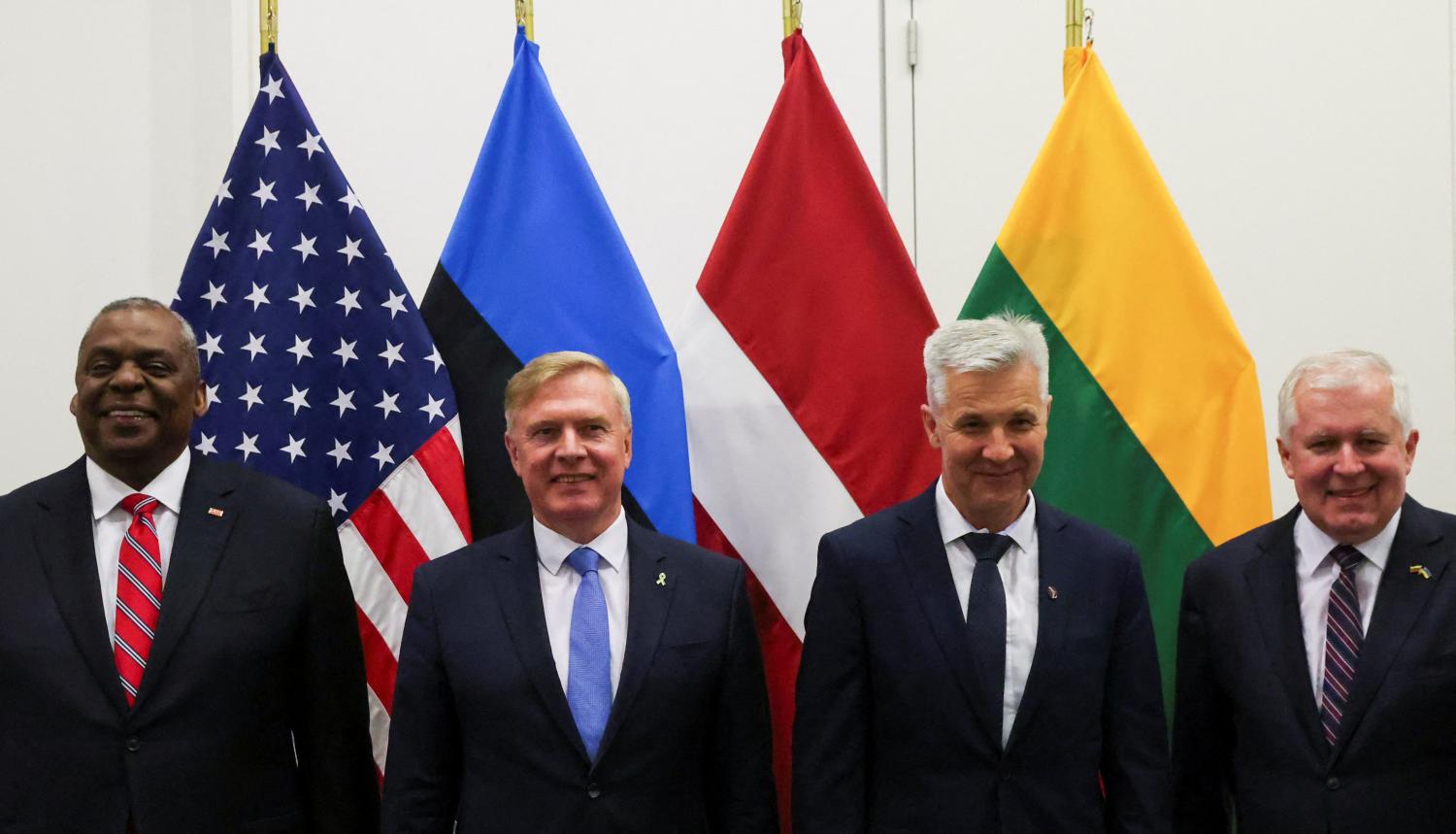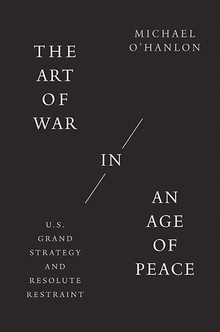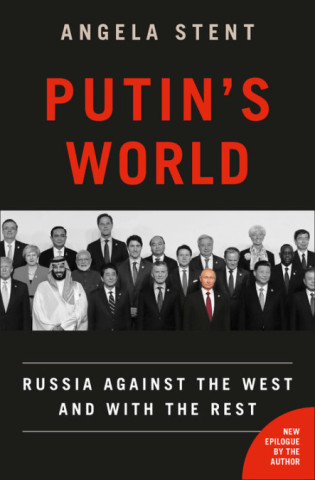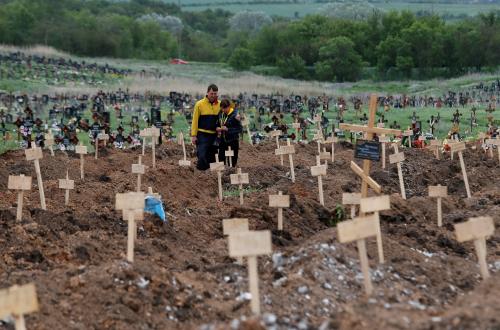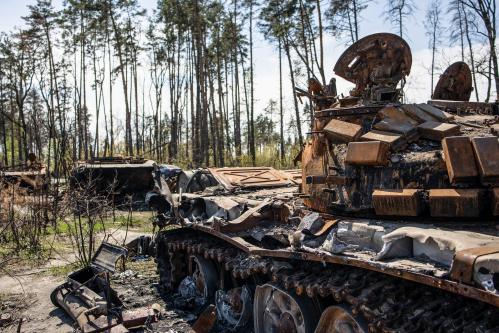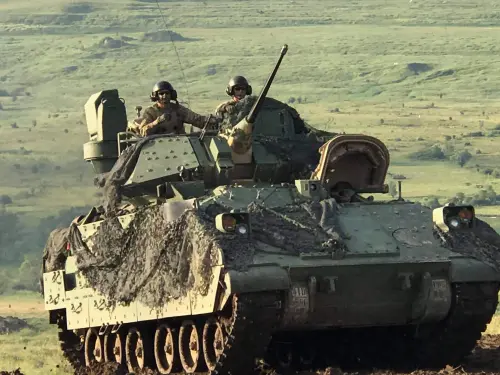This piece is part of a series of policy analyses entitled “The Talbott Papers on Implications of Russia’s Invasion of Ukraine,” named in honor of American statesman and former Brookings Institution President Strobe Talbott. Brookings is grateful to Trustee Phil Knight for his generous support of the Brookings Foreign Policy program.
EXECUTIVE SUMMARY
Even if the war in Ukraine were to end soon, events to date have already transformed the European security environment. Among the main questions that must now be addressed is this: How should the United States and its North Atlantic Treaty Organization (NATO) allies strengthen their military postures on eastern NATO territory in the future? I believe there is now a need for a permanent forward defense posture of modest size and scale, going beyond the tripwire approach NATO has employed in the Baltic states and Poland since roughly 2017.
American strategists anxious to prioritize China as the “pacing challenge” for U.S. defense strategy may object to any increase in the resources devoted to European security. That would be a mistake. Ensuring that Russia does not further destabilize Europe will have to be just as high a priority in the years to come as the China threat. That is because any scenarios that could involve hostile threats to NATO territory could raise terrifying questions about possible escalation, even eventually to the use of nuclear weapons, and could have existential implications. Moreover, despite the ongoing emphasis on Asia as the most dynamic region on Earth, Europe remains the region where America’s preponderance of democratic, advanced, prosperous allies is found — and also the region where the world wars originated in earlier eras. Its strategic significance should never be doubted. What is more, Europe’s role in addressing the rise of China will be central to any successful effort. Finally, to the extent China is seen as a major challenge, it is all the more reason that European security must be stabilized as an anchor of the future global order. The United States and allies do not have the military, economic, or diplomatic bandwidth to address escalating crises and conflict in both Europe and Asia at the same time. New crises and conflicts in Europe must be prevented before they begin, to the maximum extent possible.
I argue here that NATO should shift from what has been, in effect, a tripwire defense of the Baltic states and Poland since 2017 to a modest forward defense posture. Russian President Vladimir Putin must know of NATO’s unambiguous commitment to defend alliance territory and feel no doubt that the United States and its allies would do whatever it took to prevail in a war that he might initiate against one or more of the alliance’s members.
The United States and allies should build facilities and position forces with the intent of making this forward defense enduring.
The United States and allies should build facilities and position forces with the intent of making this forward defense enduring. The concept of rotational deployments is no longer appropriate given the scale of what is now needed, together with the severity and hostility of the Russian actions that have made such changes necessary. NATO should not adhere to its previous policy, dating to the 1997 NATO-Russia Founding Act, that ruled out permanent stationing of allied combat forces on the territories of new members. Those days are gone. Russia, with its attack on Ukraine, has now violated the foundational principle of that Act — the peaceful resolution of disputes. Nor is rotational presence less expensive than permanent basing. Indeed, by placing upward pressure on the size of the U.S. force posture, it risks being much more expensive, given the large number of units it inevitably entails.
Thus, what has been termed NATO’s enhanced forward presence (eFP) will need to beef up. Rather than have small and disparate combat formations from many countries, NATO should establish enough combat punch in Estonia, Latvia, and Lithuania that it could credibly fight to protect these countries’ territories in a future war against Russia, while awaiting reinforcement from points further west. As the alliance’s military and strategic backbone, U.S. military formations must be an integral part of that NATO mix, to make the alliance’s commitment to successful defense and military victory absolutely unambiguous. That is the most promising way to make deterrence robust, given what we now know about Putin and his romanticized, twisted, dangerous vision of a greater Russia. The force packages need not be particularly large, but they should be combat capable, positioned in forward locations, and set up for the long term, given the likelihood that Putin or a similar successor will remain on the scene for many years.
My recommended additional American force posture would include an Army brigade combat team, an Army combat aviation brigade, and two to three squadrons of Air Force tactical aircraft, all permanently stationed in the Baltic states. After such augmentations, the American force posture in Europe would grow by 10,000 to 15,000 uniformed personnel relative to pre-2022 levels (that might in fact allow a slight reduction relative to what is in Europe today, post-Ukraine invasion, with the total number of American troops winding up just under 100,000 on the continent). Other NATO states should collectively add comparable amounts of capacity to the Baltic region. Such an addition can be made from the existing force posture without necessitating a net growth in the size of the American armed forces, despite the challenges posed by China and North Korea in the Indo-Pacific theater.
THE STRATEGIC CONTEXT
NATO has lots of full-time troops — more than three million in all.1 About two million of those are already in Europe. But most, of course, are based on their respective home territories. Prior to the Russian aggression this year, only slightly more than 10,000 troops from the alliance’s biggest and most powerful militaries were stationed on its eastern front lines near Russia.
Ukraine’s courageous resistance to Vladimir Putin’s attack makes some think that no big changes in NATO force posture will be needed for the future security environment. With Russia likely bogged down on Ukrainian territory for months or years to come, and with Russian leaders now presumably sobered about the capacity of their own military, it seems unrealistic to believe that the Kremlin could add chunks of NATO territory to its military wish list.
Alas, there is another possibility. In addition to his callous brutality, President Putin has demonstrated such recklessness in this horrible attack on a sisterly neighbor that he no longer seems predictable. While not crazy, he is angry and vindictive. Meanwhile, Russian forces have suffered huge attrition and the Russian economy is in bad shape (even if Ukraine is hurting worse overall). That makes his next move hard to foresee. Particularly if he thought that by attacking part of NATO territory he could split the alliance internally and weaken its current strong consensus to punish Russia’s aggression, he might lash out. This would be, at a grand strategic level, a version of Russia’s “escalate to de-escalate” nuclear doctrine — by doing something big and bold, Russia might be able to change the whole game, and persuade some Western countries that it was time to seek some type of compromise peace rather than risk wider war and even nuclear conflict. If Putin finds his economy in great duress with no end in sight, his forces mired in a war they cannot decisively win, and NATO already treating him like an enemy, he might try to shake things up — soon, or at some point in the future.
As such, it would be prudent for NATO to shore up its eastern flank in the months and years to come. Particular areas of concern should be Estonia and Latvia, where many native Russian speakers live, and those areas in Poland where NATO is shepherding supplies into Ukraine. Putin’s fixation on the concept of a Russkiy Mir or “Russian world,” and Moscow’s claim of the right to “protect” Russians and Russian speakers wherever they may live make the concern about the Baltics particularly compelling, since about a quarter of the populations of both Estonia and Latvia are native Russian speakers.2
To be sure, NATO should reassess its capabilities and posture in other parts of Europe, too. In particular, the Black Sea region merits further attention, with particular focus on Romania, Bulgaria, and Turkey. With the likely accession of Sweden and Finland to NATO, the alliance will need to analyze the needs of the Nordic region as well. But while sensitive, and important, these other regions do not involve Russian speakers and are less relevant to the ongoing Ukraine crisis as well. The Baltics, as well as Poland given its central role in shipping weapons to Ukraine, and perhaps Romania as well, are arguably the heart of the matter.
Whatever one’s previous skepticism about NATO expansion, Western strategists should not be hesitant to do what is necessary to protect member states today.
I have historically been skeptical of NATO’s decision to expand eastward after the Cold War, and critical of NATO’s 2008 decision at the Bucharest Summit to promise Ukraine and Georgia eventual membership someday.3 These policies were, I believe, ill-advised. They were likely to strengthen the internal political standing of Russian nationalists who would portray such NATO decisions as threatening and aggressive. Such hyper-nationalistic Russians were wrong, but their perspectives were predictable. By feeding into their narratives, NATO may have strengthened them internally, led them to adopt more extreme positions, and thereby made more likely the subsequent Russian aggression against Georgia and Ukraine. That is my view. However, this take on recent history does not exonerate Russia for its brutal invasion of Ukraine. At a moral level, this war is Russia’s fault, plain and simple, even if NATO’s policies on expansion were imprudent at a strategic level. Therefore, whatever one’s previous skepticism about NATO expansion, Western strategists should not be hesitant to do what is necessary to protect member states today. They should make no distinction, moreover, between those countries already in NATO prior to 1989 and those that entered thereafter. Successful deterrence requires equal commitment to defend all alliance members.
NATO’S CURRENT FORCE POSTURE IN EUROPE
NATO has already been adjusting, of course. In the early months of 2022, the United States has added roughly 20,000 troops to the 80,000 who were previously in Europe.
Prior to 2022, U.S. force presence in Europe was roughly as follows.4 Far and away the largest presence was in Germany, with some 35,000 uniformed American personnel. Next were Italy and the United Kingdom; the United States stationed some 13,000 and 9,000 military personnel in these two countries, respectively. The total in Poland had reached 5,000. Significant numbers were also in Spain (3,500) and Turkey (2,500). In addition, there were about 1,000 in both Belgium and Norway — 450 in the Netherlands, 400 in Greece, 100 in Romania, several hundred in Kosovo with the ongoing KFOR peacekeeping mission.
Key combat elements of this U.S. footprint featured an Army Stryker regiment (essentially a midweight combat brigade team) in Germany, a light brigade in Italy, and a heavy brigade on rotation in Poland. There also were, and still are, Air Force combat wings in Germany, Italy, and the United Kingdom. Substantial logistics, electronic warfare, reconnaissance, and command/control capabilities were part of the overall U.S. presence too.5 The more important American bases in Europe include Grafenwoehr, Hohenfels, Ramstein, Baumholder, Vilseck, Spangdahlem, and Wiesbaden in Germany (for the Army and Air Force), Aviano Air Base in Italy, Lajes Air Base in Portugal’s Azores islands, Naval Station Rota in Spain, Incirlik Air Base in Turkey, and Royal Air Force stations Lakenheath and Mildenhall in the United Kingdom.6
Other NATO countries station some troops on foreign parts of alliance territory. Notably, in 2017, NATO began an enhanced forward presence in the Baltic countries as well as Poland. But the magnitudes of these deployments are quite modest, with a grand total of about 5,000 uniformed personnel in those eFP rotations. (NATO has a few other foreign deployments as well — there are about 2,000 French troops in Germany, various nations’ peacekeeping presence in the Balkans and Cyprus, a few hundred British forces on Gibraltar, as well as several members’ modest naval deployments in the waters of the Baltic Sea, North Sea, and Mediterranean.)7 The Baltic states themselves, with a combined population close to six million, collectively field more than 30,000 active-duty military personnel and a roughly similar number of reservists. They each have about one to three brigades of ground combat power, including reservists; they do not possess significant combat air power.8
All of that was prior to 2022. Since then, the U.S. presence in Europe has grown by about one quarter. Germany now hosts nearly 40,000 American forces. About 10,000 are now in Poland. Romania has welcomed about 2,500 U.S. troops and there are now almost 2,000 in the Baltics as well. Other NATO member states have also moved troops to the alliance’s eastern flank, as indicated in the NATO map below.
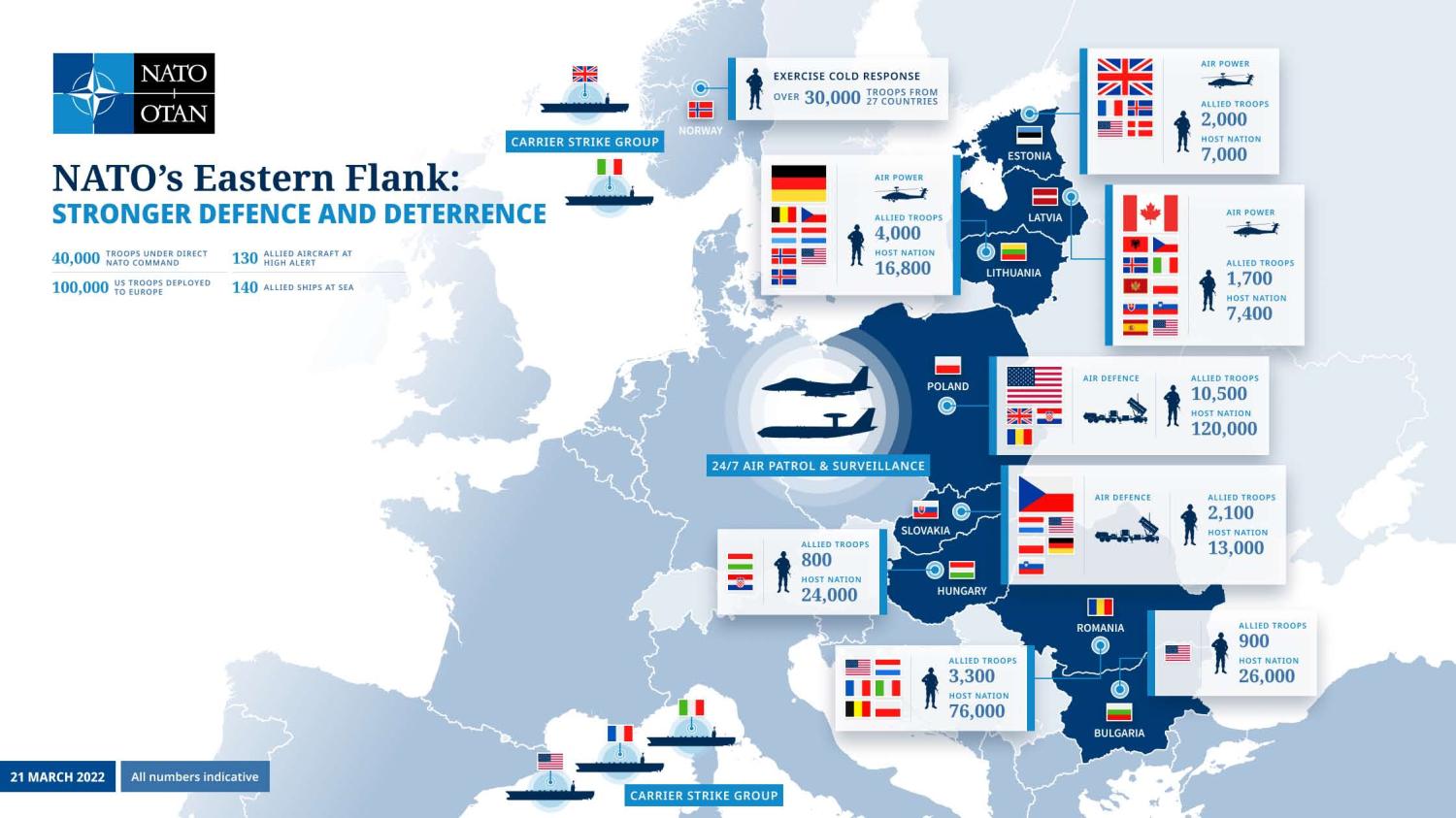
FROM A TRIPWIRE PRESENCE TO FORWARD DEFENSE OF THE BALTICS
To build a forward defense correctly, one big conceptual issue must be addressed: should the added U.S. and other NATO forces sit back a bit from the hypothetical front lines, building bases in places like Poland and Romania from which they could build up and stage large forces to respond to any Russian attack further east? Or should they be literally on the front lines, in a modern-day version of NATO’s Fulda Gap defense in Germany during the Cold War, where Russian territory meets NATO territory, as in the Baltic states?
To my mind, the answer must be both. Some front-line capability will be essential at this juncture. The greatest threats Russia might pose to Europe are those places where Russian speakers live, notably in eastern Estonia and eastern Latvia. The fact that the Baltics were once annexed by the Soviet Union only reinforces the problem. These are enduring challenges that will likely remain as long as Putin’s concept of a greater Russia persists — meaning at least as long as he is in the Kremlin, at a minimum. In addition, for the duration of the Ukraine war, NATO must also worry about those countries through which NATO ships arms into Ukraine — notably Poland, Slovakia, and Romania. Poland and Lithuania also border Russia directly at the latter’s Kaliningrad enclave; Romania borders Moldova, where it is feared that Putin may aspire to take territory as well. Hungary also borders Ukraine, but appears to be less central in current logistics efforts to support Ukraine and thus seems a less likely target of Russian retribution (under its current leader, it is also friendlier to Russia than perhaps any other country in NATO).
The United States already has a strong presence in Poland. At this juncture, the central priority should be to make what has been a rotational presence over the last six to eight years more permanent, and to enlarge it somewhat as well, in keeping with various ideas that have been developed in recent years.9 This is largely a matter of building infrastructure suitable for a long stay, with Poland likely footing much of the bill, as it has offered to do. It also makes sense to add a division headquarters to oversee the activities of the brigade combat team already in Poland, as well as smaller elements in the east near the Suwałki Gap (the narrow land corridor linking Poland to the Baltic states, with Kaliningrad and Belarus on either side of it). The American armed forces should follow through on their plan to place stocks of prepositioned equipment for an armored brigade in Poland as well. The U.S. Army also needs more transportation assets such as tank transporters to help move additional forces into the Baltics in a crisis. It also should buttress its numbers of engineering units to repair damaged infrastructure, as well as of air and missile defense units to reduce damage to such infrastructure in time of conflict. All told these additions would total several thousand more soldiers.10
Consider next the Baltics. The argument is strong for basing real American combat capability there. Something in the range of 10,000 American troops stationed in the Baltic region makes sense — made up of a brigade combat team or BCT (with some 4,000 soldiers, plus support), an Army combat aviation brigade, and two to three squadrons of U.S. Air Force tactical aircraft. These types of units are the basic building blocks of American combat power. A credible defense posture, and thus an effective deterrent, should be built on such capabilities. At least some elements of these units should be based or operate in the eastern parts of Estonia and Latvia, where many of those nations’ Russian speakers live, closest to the Russian border. In addition to their standard weaponry, they should be further equipped with technologies like smart and rapidly deployable mines so as to improve their credible capacity to slow any Russian attack until NATO reinforcements can arrive. NATO must include not just combat platforms with these units, but robust networks of advanced sensors and ample stocks of precisions munitions. Together, these capabilities constitute the kinds of “kill chains” that strategist Christian Brose rightly emphasizes as the correct central focus for modern U.S. defense planning.
Is such a package of forces enough? Some analyses based primarily on wargames have suggested that a robust defense of the Baltics would require around a half dozen additional NATO brigades. However, I do not favor such a large increase. Leave aside the fact that the Biden administration’s 2022 National Defense Strategy (rightly or wrongly) prioritizes China and Asia over Russia and Europe for force-planning purposes. The 2022 Ukraine conflict has underscored the limitations of Russian military power and in fact it has dramatically weakened the Russian armed forces. With sanctions and export controls likely to remain in place for some time to come, that reality is likely to persist. Moreover, Putin’s dream of a greater Russia has not yet led him to risk direct combat with NATO forces on NATO territory. Yes, the 2022 Ukraine war has revealed him to be a more reckless and risk-prone leader than previously assessed by many if not most of us, as I argued above in making the core case for additional NATO deployments to eastern regions of alliance territory. Still, Putin is not suicidal, and he is not unaware of the limits of his own military’s capabilities. As such, a modest force posture that demonstrates clear NATO commitment to all Baltic territory, including from the alliance’s leading military power, while creating real ground combat capability seems a solid and adequate foundation for deterrence. Airpower further west on NATO territory can quickly come to the aid of the forward-deployed forces in the Baltics, moreover — just as airpower in the Baltics, among other locations in Europe and beyond, could come to the aid of Finland and/or Sweden should Russia meddle with them.
Washington should also attempt to persuade other NATO nations to make increases in combat capability in the Baltic region comparable to its own increases. Collectively, the rest of NATO has a larger GDP and larger armed forces than the United States. Admittedly, it only spends in aggregate about half as much on national defense. But because the countries of Europe do not in general share the global burdens of the United States, especially in the Indo-Pacific region, they should in principle be capable of the kind of additional efforts proposed here — to wit, the equivalent of a combat brigade, with combat aviation and air support, and a plan to surge more forces into the Baltics if need be. It will take time for Europe, and Canada, to respond in this way, but the goal should be established now. Other changes, such as expedited procedures for NATO to gain priority access to central Europe’s rail network in a crisis, can perhaps be made sooner and should be pursued promptly.
The American changes would however be enough to deny current Russian force dispositions more than a three-to-one force advantage in normal peacetime conditions or in the early days of any crisis response — as calculated by U.S. Army officers Colonel John B. Gilliam and Major Ryan C. Van Wie. (My recommendations are similar to those of Gilliam and Van Wie, as developed before February 24, 2022, except that in response to the Russian invasion, I would add U.S. combat forces in the Baltics themselves rather than Germany, and would add forward air power as well.) That 3:1 ratio is not an ironclad law of force planning; far from it, as former Brookings scholar Joshua Epstein convincingly argued in rigorous work several decades ago.11 But it is popular enough among militaries that it has some perceptual significance in its own right. My own simple modeling suggests that if NATO has engaged forces that are one-third the size of Russia’s, it would have a good chance — though hardly a guarantee — of stymieing the Russian attack long enough to flow reinforcements into theater.12 Thus, as an interim capability, it makes sense. It strikes a balance reflecting, on the one hand, a much tenser European security environment, but on the other a rather mediocre and weakened Russian military.
In conducting force planning, it is important neither to underestimate nor overestimate the potential adversary. Russia could, in a future war, avoid some of the mistakes witnessed in its initial onslaught against Ukraine — sticking to the roads where forces can be easily located and attacked and bottled up, failing to cover vehicle flanks with dismounted infantry, failure to provide adequate artillery support for maneuver forces, communicating in the open without encryption, providing poor tactical leadership for combat units. But it will still be saddled with an outdated military, severely weakened by the war in Ukraine. Further, it will lack access to advanced Western electronics with which to modernize its armed forces for years to come. Again, the argument seems compelling for a relatively modest NATO force posture in the Baltics — yet one made up of major combat units organized as such, unlike the current eFP.
CONCLUSION
As 2022 unfolds, and tragedy in Ukraine continues, NATO is nonetheless in strong military and political shape. No major surgery is needed to right-size or reposition the alliance for the challenge of a more reckless Russia. Moreover, NATO is already adapting somewhat to the new strategic environment, and the general trend is sound. Its responses include modest growth in defense spending across much of the alliance and the likely addition of Sweden and Finland to the alliance’s roster, as well as ongoing efforts in the realm of economic warfare.
Yet more change is needed nonetheless. In the crucial Baltic region, NATO should shift from what has been an impressive tripwire stance since 2017 to a modest but meaningful forward-defense posture. NATO should have enough combat power in Estonia, Latvia, Lithuania, and nearby locations that it could immediately resist any Russian attack, be it in the form of “little green men,” other covert aggression, or a more classic cross-border attack. But Russia’s capacities in these areas are generally limited, so NATO’s response need not be monumental in scale. The United States should station a brigade combat team, a combat aviation brigade, and two to three squadrons of tactical fixed-wing airpower in the Baltics; it should complete planned prepositioning of vehicles for a brigade combat team in Poland while also adding transport, engineering, and air and missile defense capabilities there. NATO allies should commit to making comparable additions to those recommended here for the U.S. presence in the Baltics as soon as they can.
The good news is that these changes do not require huge additional expense and therefore need not fundamentally disrupt the Pentagon’s understandable desire to focus much future modernization on the Indo-Pacific. Once facilities are built, keeping U.S. forces abroad rather than at home typically adds about 10% to their annual cost. For 15,000 U.S. military personnel, that would equate to the rough vicinity of $1 billion a year.13 Local partners can handle many of the expenses of building those new facilities.
NATO’s longstanding policy of not basing combat units in eastern member states — as a nod to Russian security sensitivities — is no longer relevant in light of Russia’s attack on Ukraine.
If the Army and Air Force permanently station small numbers of units abroad, in Poland and the Baltics, rather than maintaining a new forward posture with frequent rotations of numerous units, they can likely sustain this burden without enlarging their force structures. The Army’s past preference to rotate units into Poland (and South Korea) is understandable. This approach gives more soldiers experience at preparing for deployment, as well as a chance to serve abroad. But it also creates strain on the force structure, given that at least three units are needed to sustain a single continuous deployment (due to the need for training, preparation, and then recovery). At this juncture, NATO’s longstanding policy of not basing combat units in eastern member states — as a nod to Russian security sensitivities — is no longer relevant in light of Russia’s attack on Ukraine. Moreover, the very modest stationing of combat units proposed here for the Baltics and Poland cannot pose a meaningful threat of cross-border aggression against Russia.
Permanently stationing 15,000 more American troops in the Baltics and Poland, while asking European and Canadian allies to make similar additional efforts in eastern Europe as well, is an affordable and prudent response to the increased Russian threat to NATO’s forward regions.
-
Acknowledgements and disclosures
The author would like to thank Célia Belin, Bruce Jones, Robert Kagan, Kelly McElveny, Ted Reinert, Alejandra Rocha, Melanie W. Sisson, Rachel Slattery, and Constanze Stelzenmüller for their help with this paper.
-
Footnotes
- The Military Balance 2022 (London: International Institute for Strategic Studies, 2022), 521-522, https://www.iiss.org/publications/the-military-balance/the-military-balance-2022.
- See Vladimir Putin, “Article by Vladimir Putin ‘On the Historical Unity of Russians and Ukrainians,’” President of Russia, July 12, 2021, http://en.kremlin.ru/events/president/news/66181; Robert Coalson, “Putin Pledges to Protect All Ethnic Russians Anywhere. So, Where Are They?” Radio Free Europe/Radio Liberty, April 10, 2014, https://www.rferl.org/a/russia-ethnic-russification-baltics-kazakhstan-soviet/25328281.html; Fiona Hill and Clifford G. Gaddy, Mr. Putin: Operative in the Kremlin (Washington, DC: Brookings Institution Press, second edition, 2015), 369-376; Kathryn E. Stoner, Russia Resurrected: Its Power and Purpose in a New Global Order (Oxford, U.K.: Oxford University Press, 2021); and Angela E. Stent, The Limits of Partnership: U.S.-Russian Relations in the 21st Century (Princeton, NJ: Princeton University Press, 2015).
- Michael E. O’Hanlon, Beyond NATO: A New Security Architecture for Eastern Europe (Washington, DC: Brookings Institution Press, 2017); see also, on the origins of the “open door” policy, James Goldgeier, Not Whether But When: The U.S. Decision to Enlarge NATO (Washington, DC: Brookings Institution Press, 1999).
- Numbers derived from “DoD Personnel, Workforce Reports & Publications,” DMDC, U.S. Department of Defense, https://dwp.dmdc.osd.mil/dwp/app/dod-data-reports/workforce-reports.
- Alexander R. Vershbow and Philip M. Breedlove, “Permanent Deterrence: Enhancements to the US Military Presence in North Central Europe,” (Washington, DC: Atlantic Council, February 2019), 45-46, https://www.atlanticcouncil.org/in-depth-research-reports/report/permanent-deterrence/; and The Military Balance 2022, International Institute for Strategic Studies, 60-63.
- The Military Balance 2022, International Institute for Strategic Studies, 61-63; and Michael E. O’Hanlon, Defense 101: Understanding the Military of Today and Tomorrow (Ithaca, NY: Cornell University Press, 2021), 36-38.
- The Military Balance 2022, International Institute for Strategic Studies, 88-163, 521-522.
- Ibid., 100-101, 122-125.
- See Mark T. Esper, A Sacred Oath: Memoirs of a Secretary of Defense During Extraordinary Times (New York: HarperCollins Books, 2022), 420-30.
- Alexander R. Vershbow and Philip M. Breedlove, “Permanent Deterrence,” 39-43.
- Joshua M. Epstein, Conventional Force Reductions: A Dynamic Assessment (Washington, DC: Brookings Institution Press, 1990), 51-65.
- Michael E. O’Hanlon, The Future of Land Warfare (Washington, DC: Brookings Institution Press, 2015), 82-90.
- Adam Talaber, “The U.S. Military’s Force Structure: A Primer,” (Washington, DC: Congressional Budget Office, July 2016), https://www.cbo.gov/publication/51535; and Michael E. O’Hanlon, Defense 101, 70-80.

